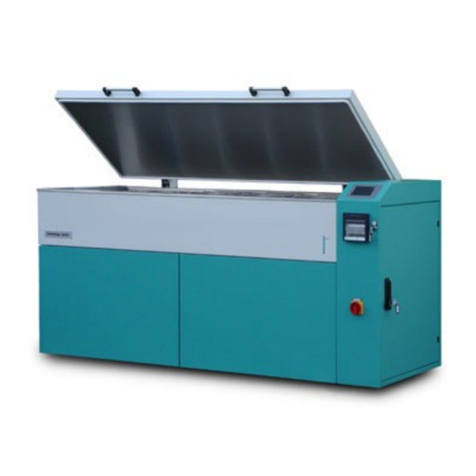
2 Safety instructions 5
2 Safety instructions
This machine is constructed according to DIN EN 378-1class A. This
means it is allowed to run this machine in a room where people are
sleeping, disabled persons are working, or a lot of not instructed people
are present. So there are no special requirements in the training of the
people working with, or nearby the machine.
A mix of 45 % water and 55 % glycol is used as a cooling liquid. Ac-
cording to the European water protection standard the cooling liquid is
assigned to level 0. There are no special requirements for environmental
or water protection for cooling liquid.
Until 2017, the CDF machines were built with the refrigerant R507. Since
2017 the Schleibinger CDF machines are being built with the refrigerant
R448a. Compared with CO2(GWP = 1.0) R448a has a high potential for
global warming (GWP = 1387) but lower than the previuous used R507
(GWP = 3800). This fact requires a careful handling with the refrigerant.
Service and repair jobs at the cooling machine are allowed only for well
trained and special educated persons. Please contact Schleibinger for
further questions.
The lubricant of the cooling machine is long-term stable and does not
need to be changed during the service life. The oil is classified at water
dangerous class 1. There are no special oil protection requirements
necessary. The CDF machine stops automatically when a leak occurs
in the system.
The CDF test machine has a mains connection with a 3x 32A/400V/50Hz
CEE connector. As circuit protection 3x 32A are necessary.
While using CDF equipment the environmental conditions should be at
10 to 28 °C at maximum 65 % relative humidity. At higher humidity,
more condensation may be present on some machine parts. Below 10
°C, a special winter controller should be ordered with the machine. At
temperatures above 28 °C additional water cooling system is required.
Opening the lid of the cooling bath is only permitted if the bath
temperature is close to room temperature. We strongly recommendAttention!
using waterproof isolation gloves for protection. Contact to the cooling
bath at low temperatures may cause freezing the skin.
2.1 Protection switches
The CDF machine is equipped with the following safety and security
components, which are adjusted by Schleibinger.
• Overtemperature protection for the heating unit (70 °C)
• Level indicator for the testing bath and the buffer.
• Safety switching device for limiting the high pressure for the com-
pressor.
• Safety switching device for limiting the low pressure for the com-
pressor
Changing the setup of the security devices is prohibited! Any ma-
nipulation will lead to a total warranty loss!Attention!





























